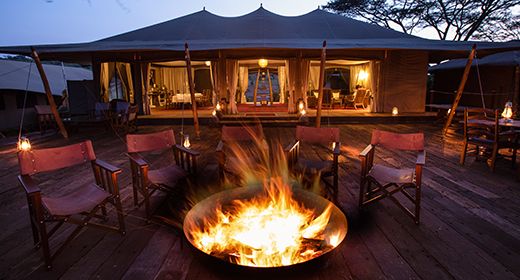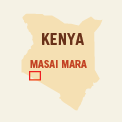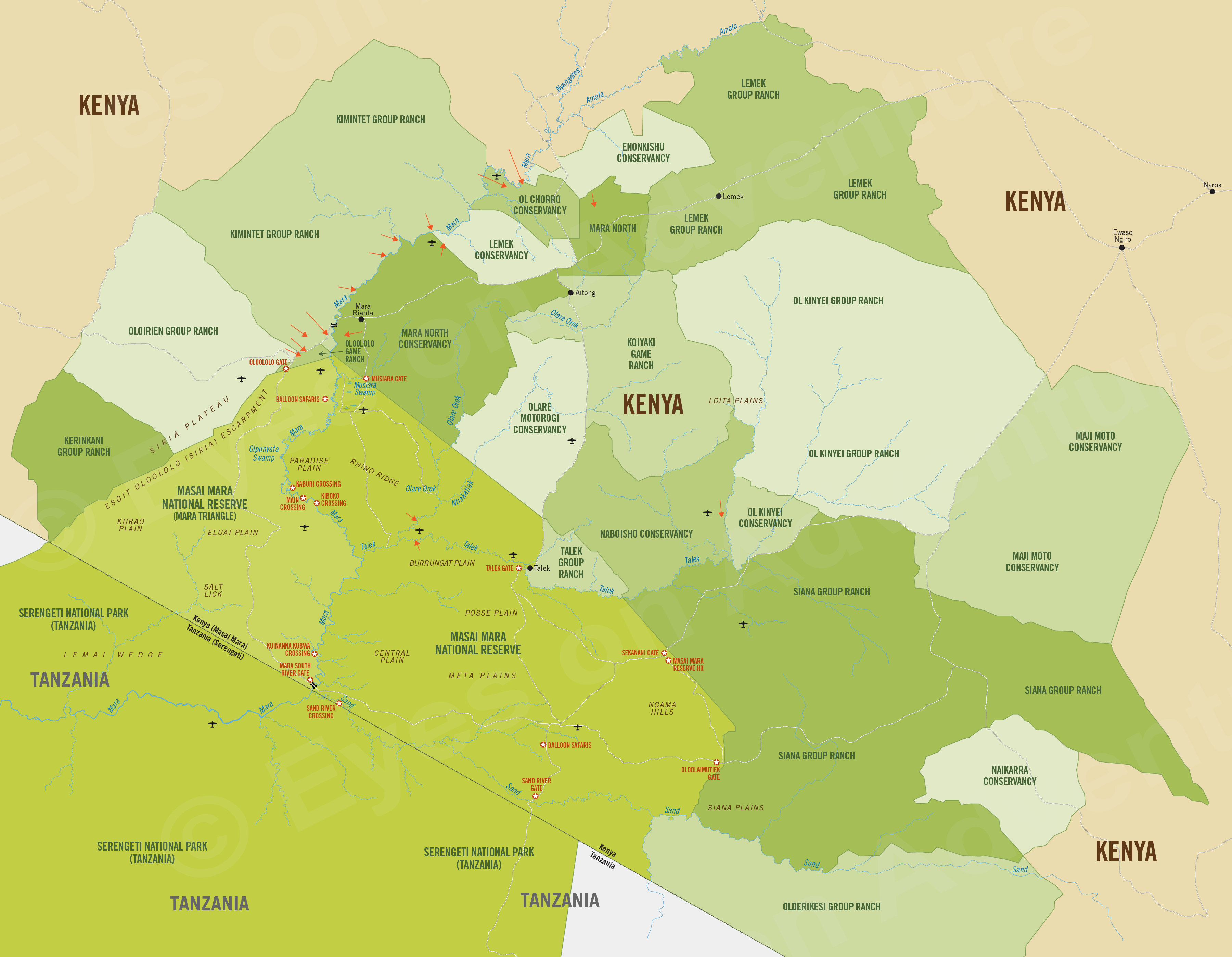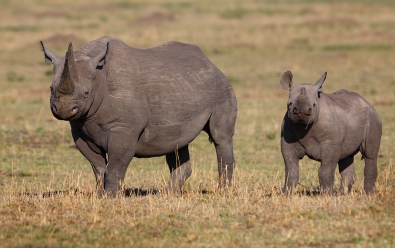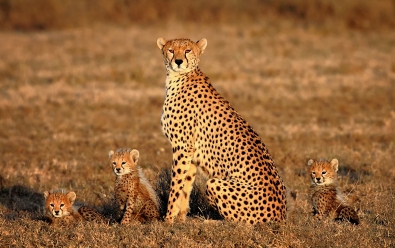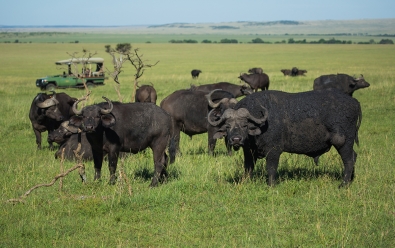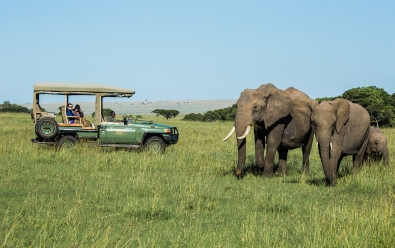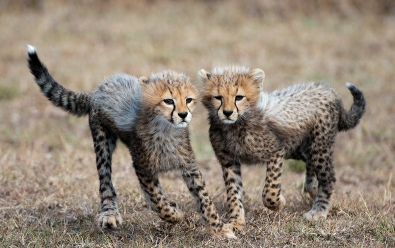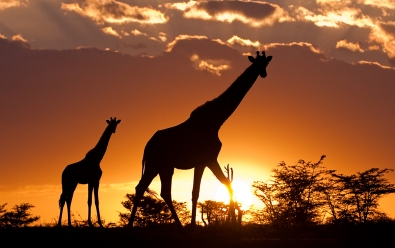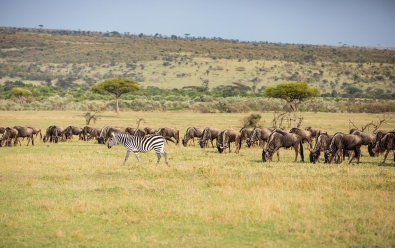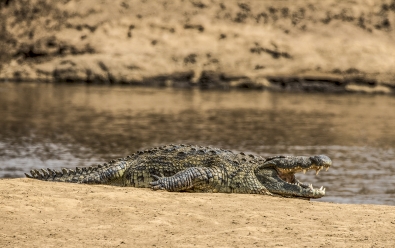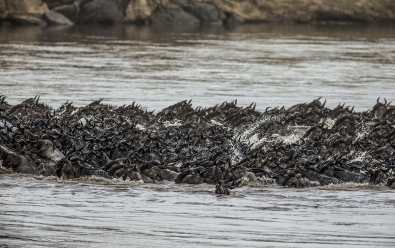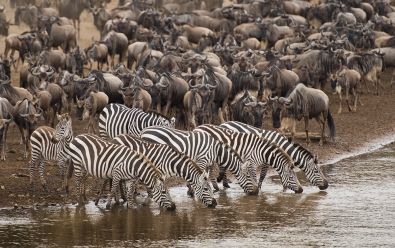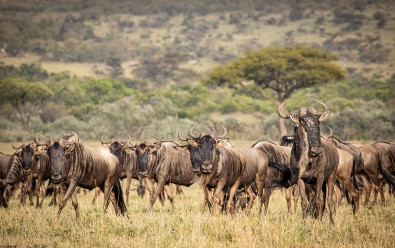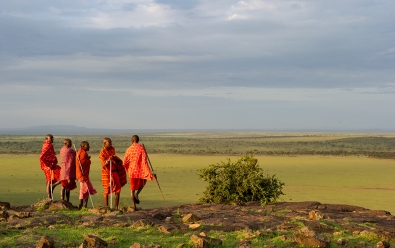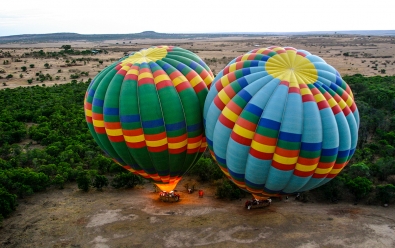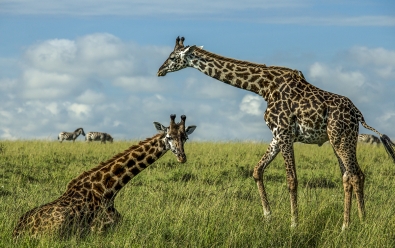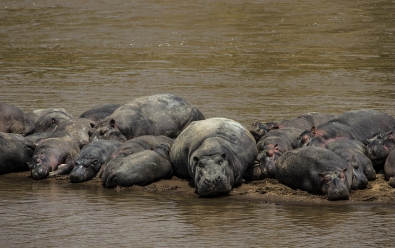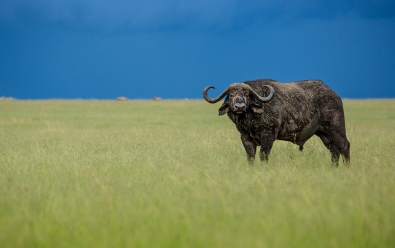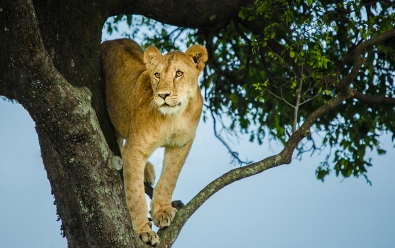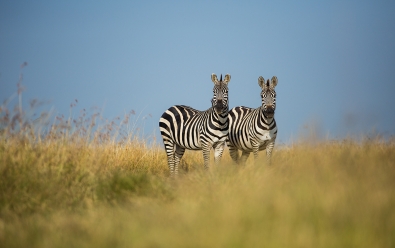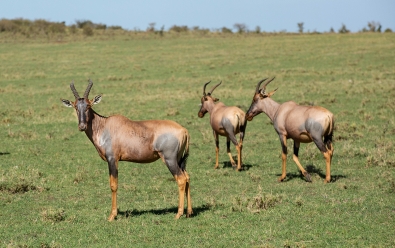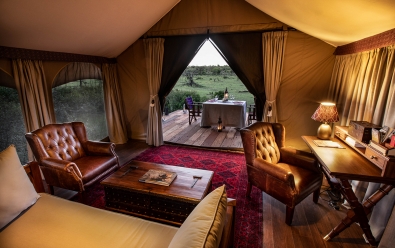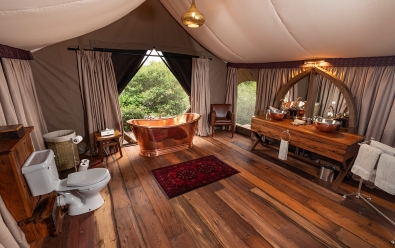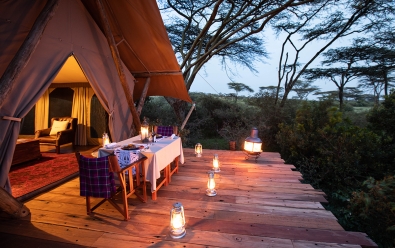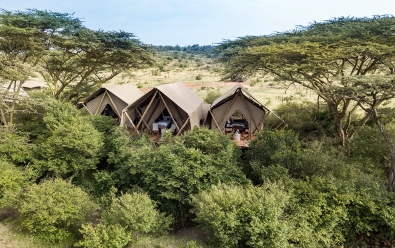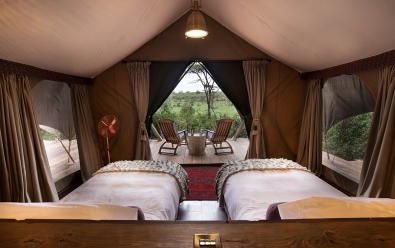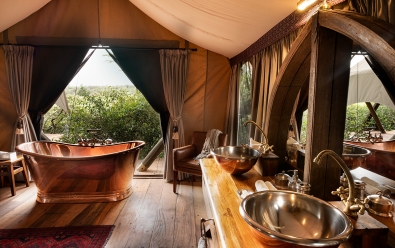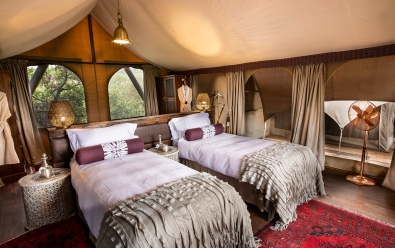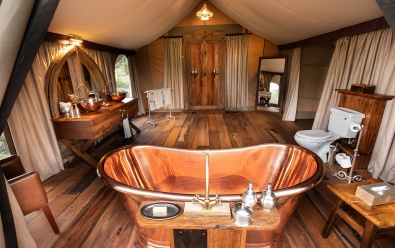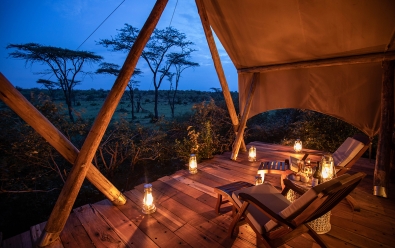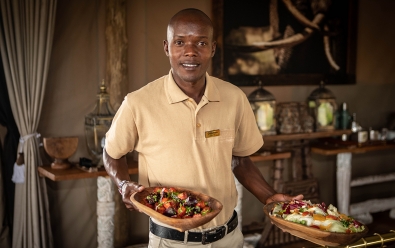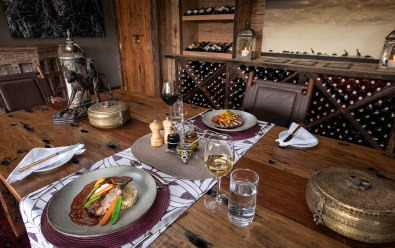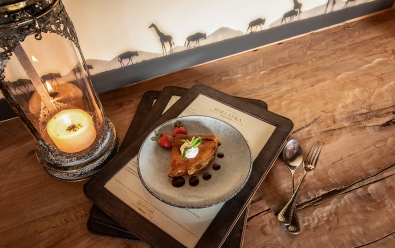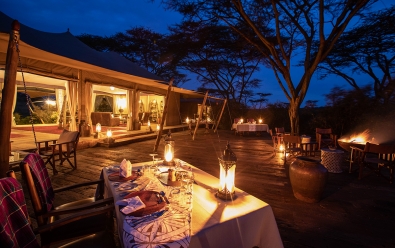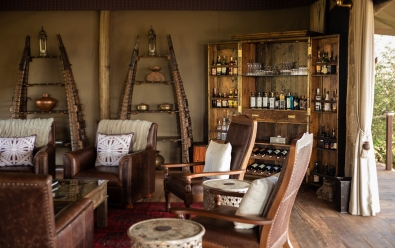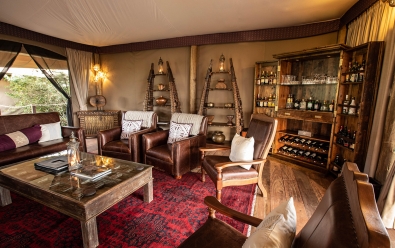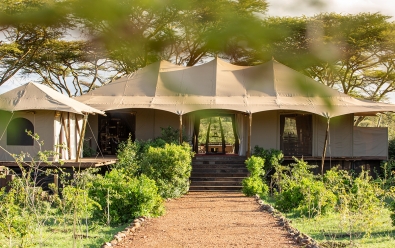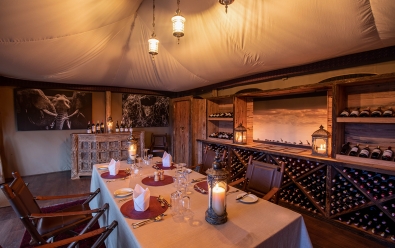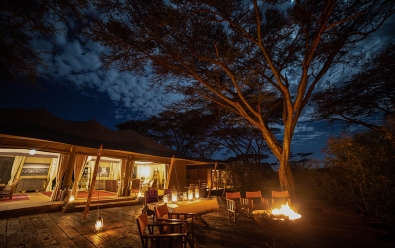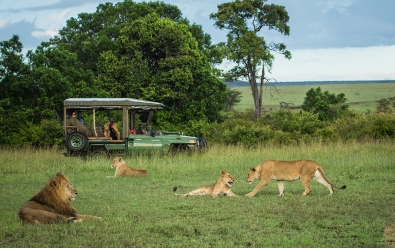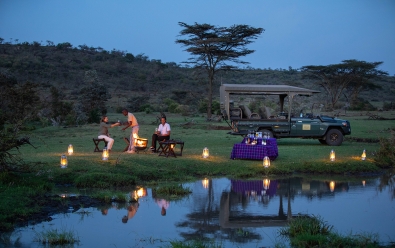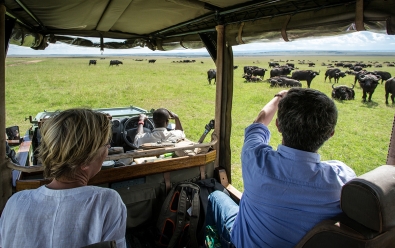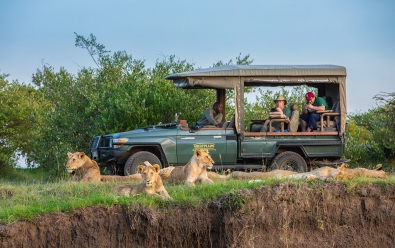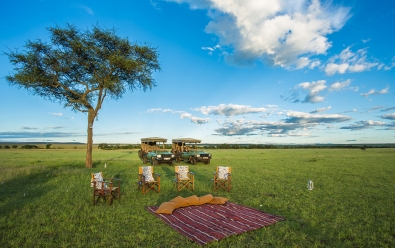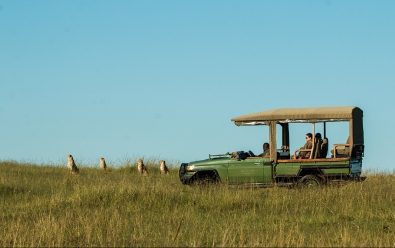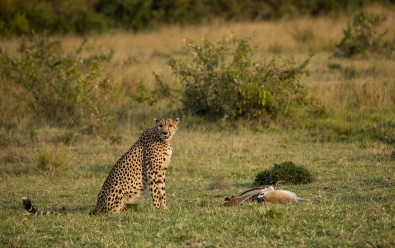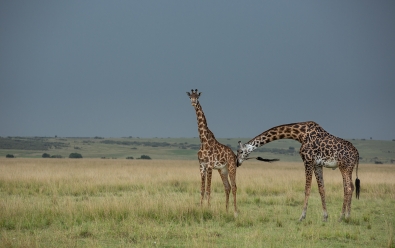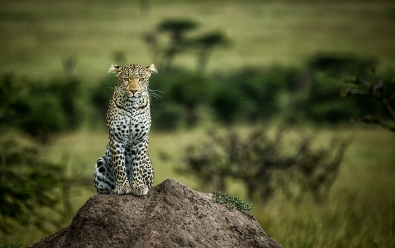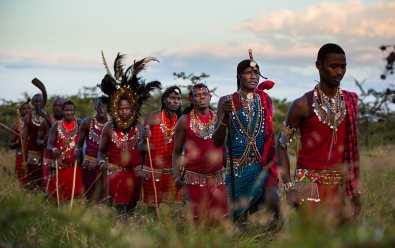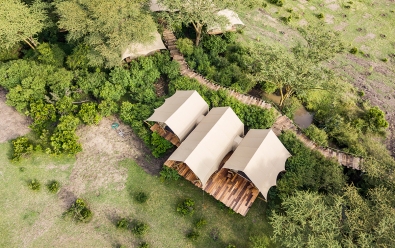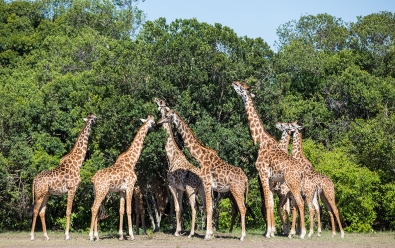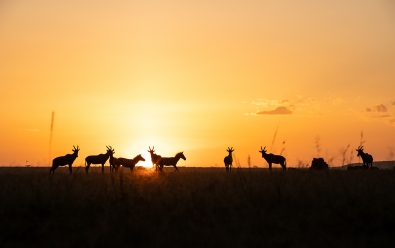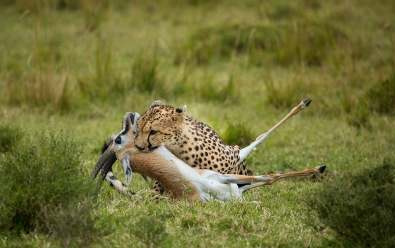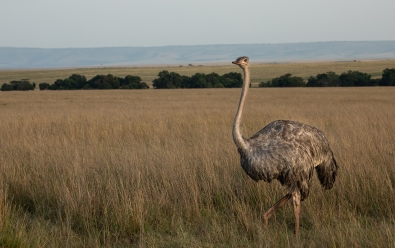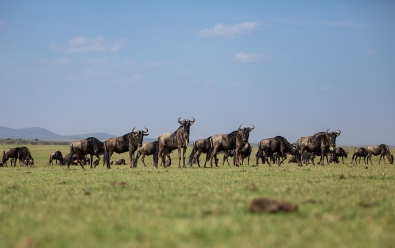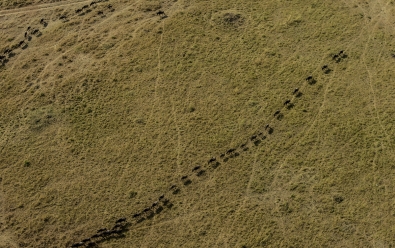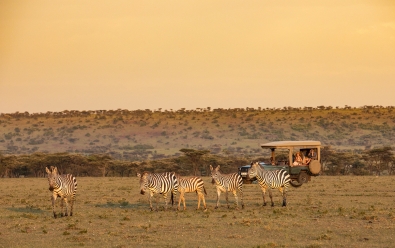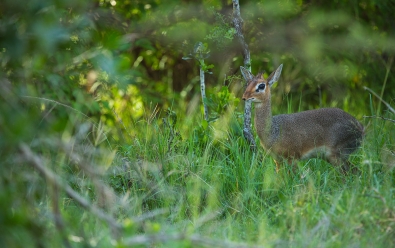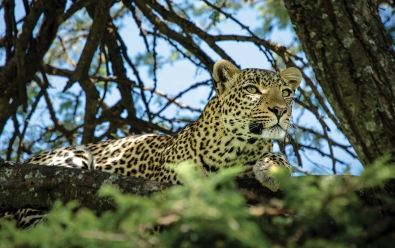Mara Nyika Camp
Highlights
- Luxury camp in a private conservancy, far from the crowds.
- Excellent wildlife viewing throughout the year.
- Game drives, off-roading, night drives, culture.
- The area is visited by the Great Migration.
Location
- Naboisho Conservancy
- Greater Masai Mara
- Southwest Kenya
Mara Nyika is a luxury safari camp located in a wildlife-rich, private conservancy bordering the Masai Mara Reserve and offering very low tourist densities and a true wilderness setting.
The camp's location within the private, 86-square-mile (222-sq-km) Naboisho Conservancy means that guests are able to enjoy the abundant and diverse wildlife of the Masai Mara region without experiencing a crowded wildlife sighting, like those that can sometimes occur in the neighboring Masai Mara National Reserve. This said, guests do have the option of full-day game drives into the national reserve if they wish.
With a relatively small number of safari camps in this extensive, private conservancy, guests staying at Mara Nyika Camp are guaranteed an exclusive wildlife safari experience in a setting that feels like being alone in a wilderness. Read more about Naboisho Conservancy below.
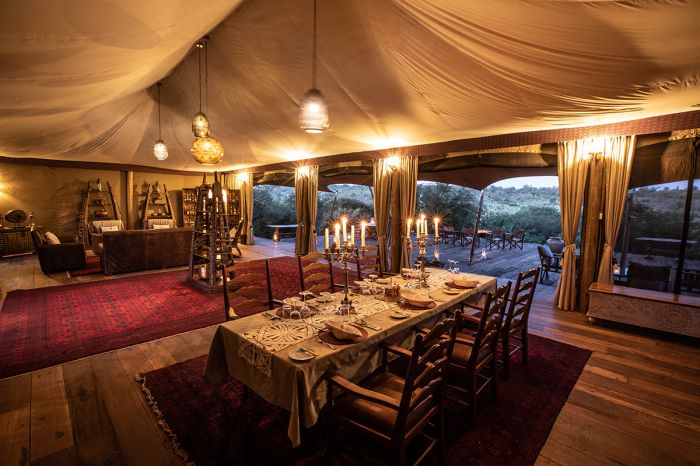
Main area tented space at Mara Nyika Camp.
The camp is set amongst an open, Acacia woodland fringing the banks of an ancient, ephemeral riverbed with views onto a rock-strewn plain that attracted good numbers of wildlife. During the peak Great Migration months (generally mid-July thru October, read more below), guests staying at Mara Nyika Camp may want to spend time in the National Reserve to explore a bit more, so full-day safaris to the reserve are offered.
Activities at Mara Nyika Camp focus on game drives in custom-designed, open 4x4 vehicles to see the diverse wildlife. Those looking for additional adventures can pre-book an early morning, hot-air balloon flight above the Masai Mara and get an incredible, bird's-eye view of this spectacular setting from above (highly recommended). Cultural experiences with the local Maasai people are also offered.
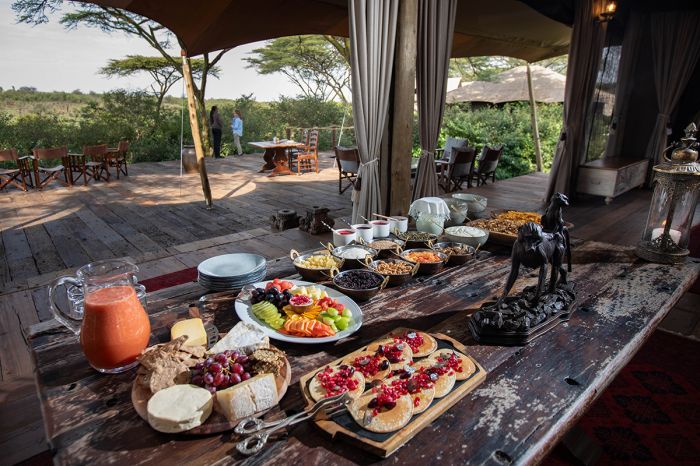
Breakfast table at Mara Nyika Camp.
Mara Nyika Camp offers five, spacious, wood-and-canvas guest suites, two of which are two-bedroom suites suitable for a family with two adults and 2 children or 3 adults traveling together. Each bedroom includes a complimentary DSLR camera and lenses and a pair of high-quality binoculars for guests to use during their stay.
The open-plan, tented, guest suites are spacious and feature a small lounge and a large outdoor deck that includes lounge seating and private dining space. The two-bedroom suites include an outdoor campfire on the deck. The suites include plumbed, en-suite facilities with a luxurious, copper tub, and an indoor shower.
The main camp area is a spacious, open-plan, tented structure built atop a raised deck and reminiscent of a luxury safari from colonial times, with a lounge, indoor dining space, and a bar. Separate tented structures in the main area include a wine room with a dining table, an interactive kitchen, and a safari boutique.
The main area opens onto a deck built from reclaimed teak, railroad ties with outdoor dining space and a campfire area. Spa wellness treatments are offered en-suite for some additional pampering between safaris.
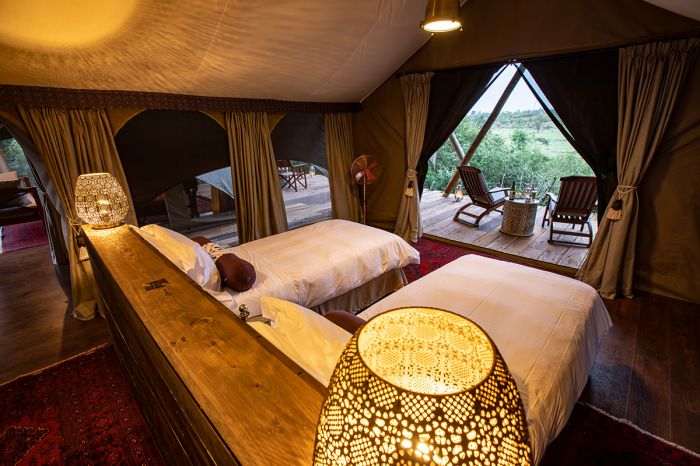
Second bedroom in a two-bedroom guest suite at Mara Nyika Camp.
Mara Nyika Camp is owned and operated by Great Plains Conservation, an organization whose mission is to blend sustainable tourism with the conservation of wildlife environments. Great Plains is headed by the husband-and-wife team of Beverly and Dereck Joubert, who are well known to wildlife enthusiasts for their outstanding films, most of which have been created in conjunction with National Geographic.
Great Plains use the term “Conservation Tourism” to describe what they do. They define it as the use of quality-led tourism experiences that are environmentally sound, with the benefits going specifically into making the conservation of an area viable and sustainable.
The Great Plains model takes stressed and threatened environments, surrounds them with compassionate protection and intelligent, sustainable management, and funds them with sensitive, low-volume, low-impact, tourism.
Mara Nyika is one of only a few Relais & Châteaux properties in Kenya.
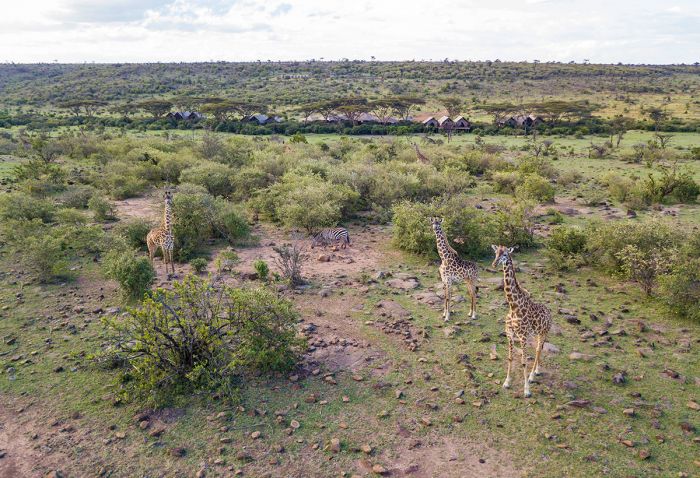
Giraffes browsing in front of Mara Nyika Camp.
Great Plains are one of Africa's leading safari operators and they strive to minimize energy consumption at all their camps. The camp was constructed using only repurposed hardwoods and all of the camp’s electricity comes from its solar-power system.
Mara Nyika Camp is at the top in terms of its environmental credentials and careful appointments. Strict eco-friendly environmental standards are maintained so that no harmful chemicals or waste is allowed to enter the pristine ecosystem of the Masai Mara.
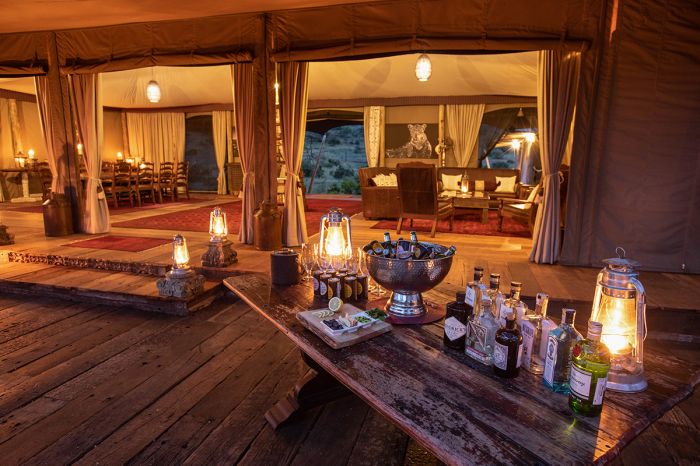
Main guest area at Mara Nyika Camp.
About the Masai Mara
The Greater Masai Mara includes the Masai Mara National Reserve as well as numerous private conservancies that border the reserve. The national reserve and bordering conservancies are often collectively referred to simply as "the Mara".
The Greater Masai Mara is part of a much larger ecosystem that includes vast protected areas directly to the south in Tanzania, including Serengeti National Park, the Ngorongoro Conservation Area, and other reserves that together make up the Greater Serengeti.
The combined Greater Serengeti-Mara ecosystem, which combines the areas described above, covers roughly 15 000 square miles (39 000 sq kms).
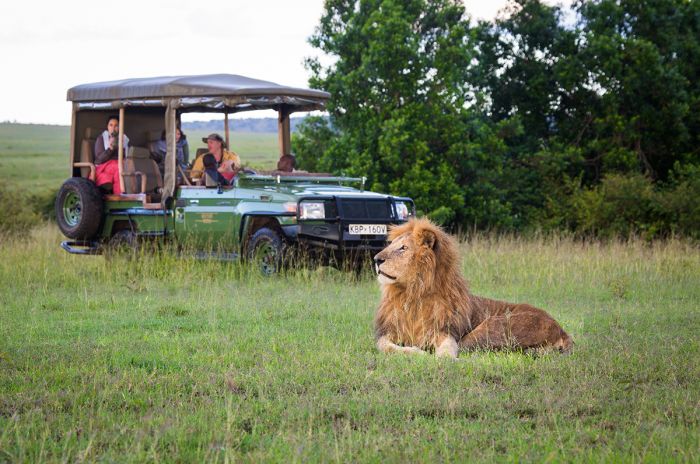
Lion sighting on a game drive.
The Serengeti-Mara is home to a very large number and diversity of wild animals and is also the location of the well-known "Great Migration" of over 2 million herbivores (read more below). This is arguably Africa's greatest overall wildlife destination.
Wildlife densities in the Greater Masai Mara are some of the highest in Africa, with commonly seen herbivores including blue wildebeest, plains zebra, Thomson's gazelle, topi, Grant's gazelle, hartebeest, giraffe, elephant, buffalo, impala, waterbuck, bush bug, warthog, and many others.
Predators seen often include lion, leopard, spotted hyena, cheetah, serval, and jackal. Hippo and crocodile are found in large numbers in the Mara River.
Masai Mara National Reserve
The national reserve forms the core protected area of the Greater Masai Mara, covering 583 square miles (1 510 sq kms) and officially protected since 1974. The reserve is functionally the same as a national park, with restrictions on off-road driving and open to the public, which includes self-drivers coming for the day, as well as guests staying at one of the accommodations within the reserve (of which there are many).
The Mara Triangle
The Mara River flows southward through the national reserve on its way into Tanzania and eventually into Lake Victoria to the southwest. The river also separates the national reserve into two separately-managed sections: the area to the west of the Mara River is known as the "Mara Triangle", while the area to the east of the river is simply the Mara National Reserve.
The Mara Triangle covers 197 square miles (510 sq kms), which is roughly one-third of the reserve and there are relatively few safari camps in this section, so the number of vehicles and tourists, especially during the peak months when the migration is in present, is much lower in the Triangle section than in the section east of the Mara River.
The Great Migration
One of nature's greatest living spectacles is the Great Migration, a term given to describe the year-long, circular, clockwise march of over two million herbivores across the Masai Mara and Serengeti grasslands. The migration animals are made up entirely of two species: the blue wildebeest and the plains zebra (the majority of which are wildebeests).
The migrating herds follow their instincts to seek out fresh grazing and so the migration is ongoing, with the herds ever moving and taking a full year to complete a cycle across the Masai Mara and Serengeti. The animals move not as one herd, but as tens of thousands of animals in multiple herds of various sizes and spread out for many miles as they move.
The wildebeests and zebras take advantage of strongly seasonal conditions, spending the wet season (November through May) on the plains of Tanzania's Serengeti and the dry season in Kenya's Masai Mara. The wildebeests give birth between January and March on the short grass plains in Tanzania.
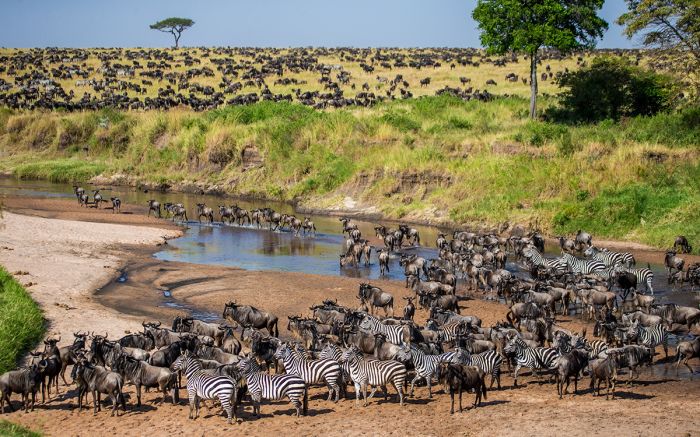
The Great Migration along the Sand River in the Masai Mara.
The timing of the migration is rarely ever the same year-to-year, as local conditions influence grass growth and as such, the location of the bulk of there animals cannot be known precisely. Rains and other unknown conditions seem to direct the timing of the migration, but generally, it is known within several weeks when the animals will be in a general location.
The migration typically crosses north into Kenya and the Masai Mara beginning sometime in mid- or late-July and they spend around three months in the Greater Masai Mara. The herds head back south into Tanzania sometime in October.
Although many visitors time their visit to the Masai Mara to coincide with the Migration, the Greater Mara has superb wildlife viewing outside of the migration period. This is because it is only the wildebeests and zebras that migrate, the rest of the animals, including the major predators like lion, leopard, spotted hyena, and cheetah, as well as all the other herbivores, including springbok, gazelles, elephant, topi, hartebeest, and many others, do not migrate.
A popular aspect of experiencing the Great Migration is observing a herd as it crosses the Mara River, which requires animals swimming through waters inhabited by large Nile crocodiles that wait for a chance to get their first substantial meal in many months.
The dramatic river crossings (which take place along the Mara River in both Kenya and Tanzania) are certainly a spectacle and not for the faint of heart, with many of the wildebeest and zebras taken by crocs or succumbing to drowning or trampling in the chaos.
The best chances for seeing a Kenya Mara River crossing are during July and August, when the crocodiles are still very hungry.
Mara Conservancies
Over the past two decades, nearly all of the land situated surrounding the Masai Mara National Reserve has been organized into protected and self-managed reserves by various tribes of the Maasai people that own the land. The result has been a great expansion of wildlife tourism and the construction of safari tourism camps and lodges.
Note that some of the conservancies use the name 'group ranch' instead of conservancy.
Many of these conservancies, particularly those that directly border the national reserve, offer wildlife viewing that is even just as good, and arguably even better than inside the reserve, primarily because the conservancies are only available to tourists staying at a camp within the conservancy and unlike the national reserve itself, are not accessible to self-drive day visitors.
The exclusivity of the conservancies means that there are fewer game drive vehicles and a far lower density of tourists. Further, the number of vehicles allowed at any specific animal sighting (such as a lion kill or a leopard in a tree) is managed to prevent the oft-seen situation where an animal, such as a cheetah, is surrounded by 20 or more cars in the national reserve.
Staying in one of the Mara Conservancies offers guests the opportunity to have an exclusive game-viewing experience (due to the reduced tourist numbers compared to inside the national reserve), while still allowing day visits into the reserve proper (entrance fee required). A day visit into the reserve might allow seeing a major wildebeest/zebra river crossing during the migration months. Guided safari walks (during the day) and game drives past sunset are another option inside the conservancies that is not permitted inside the national reserve.
NABOISHO CONSERVANCY
Created in 2010, the Naboisho Conservancy (NC) is a superb game-viewing destination situated directly north of the Mara Reserve. The NC covers 86 square miles (222 sq kms) of land that was previously part of the Koyiaki-Lemek Group Ranch. Naboisho shares a border with and lies southeast of the Olare Motorogi Conservancy.
Naboisho's landscape is one of classic Mara grasslands, rolling hills, Acacia scrub, and riparian woodland. Like the Mara Reserve, Naboisho boasts good numbers of cheetah, lion, leopard, and spotted hyena. Plains game is also abundant, with elephant, zebra, Masai giraffe, Thomson's gazelle, Grant's gazelle, eland, and more. The number of vehicles at a sighting is strictly limited, which means a more exclusive game-viewing experience than in the National Reserve.
ROOMS INCLUDES & EXCLUDES CHILDREN FACILITIES ACTIVITIES
Accommodation
5 guest accommodations in total comprising:
- 3 luxurious, double-bedded, wood-and-canvas suites. Twin-bedded setup is also available.
- 2 two-bedroom wood, wood-and-canvas suites. One of the bedrooms is a double setup (convertible to twin) and the second bedroom is a twin setup. These suites are suitable for a family with 2 adults and 2 children or 3 adults sharing.
Each spacious, tented, treehouse-style accommodation is constructed atop elevated wooden decking with views of the surrounding, grassland plains. The fully-plumbed, en-suite facilities include a luxurious copper bath, indoor shower, double-basin vanity, and separate flush toilet.
The guest suites are connected to the main camp area by a raised, wooden walkway.
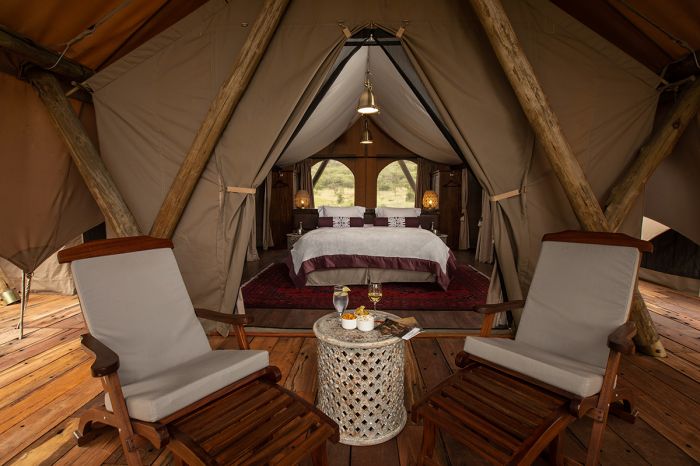
View into guest bedroom (2-bedroom suite) at Mara Nyika Camp.
The guest suites are essentially oversized, Meru-style, canvas safari-tents featuring pitched ceilings and mesh windows, but with all the creature comforts one could require, making for a classic, yet luxurious, tented-safari experience.
The suites are constructed atop elevated platforms made from reclaimed, teak railroad ties and are spacious, covering toughly 1 000 square feet (93 sq meters) of inside space with an outdoor deck of nearly equal size. The outdoor space is accessed via the lounge or the bedroom and features comfortable lounge seating and room for private, al-fresco dining.
Zip-up doorways lead into a lounge area at the front of the suite and then the bedroom, which can be arranged as a double or twin-bedded setup. The lounge includes comfortable seating, a fully-stocked, refrigerated mini-bar with drinks of choice, and a coffee/tea station. The bathroom facilities are situated to the rear of the suite.
The entry to the two-bedroom suites leads into a central, shared lounge area with the bedrooms on either side. Each bedroom has its own bathroom facilities with an indoor shower, double-basing vanity, and flush toilet. One of the bathrooms has a luxurious, copper bath.
Other features include a writing desk and chair and plenty of storage space for clothes and personal items behind the bed. The double-suites include a large, outdoor deck with lounge-style seating, a campfire area, and lots of space for private meals.
Items and features in all of the guest units include:
- Writing desk and chair.
- Electronic safe.
- Standing fan.
- Fully-stocked, refrigerated mini-bar with choice of drinks.
- Tea and coffee making facilities.
- Low-voltage hairdryer (the solar-powered system does not support standard-voltage hairdryers, shavers, or any high-wattage device).
- Yoga mats and bands.
- One pair of high-quality binoculars and a professional camera body and lens kit for complimentary use. Photos will be downloaded to a memory stick on guest’s departure.
- Wi-Fi in the guest suites and main camp area.
- Multi-plug charging facilities for mobile devices.
- Personal amenities, including soap, shampoo, conditioner, and lotion.
- Cell service is relatively reliable. No cell phones or computers are allowed in the public areas of camp or on game drive vehicles; only in the privacy of guest suites.
Mara Nyika Camp can accommodate a maximum of 14 guests in total: 2 guests in each of the 3 standard suites and 2 adults + 2 children (or 3 adults) in the 2 two-bedroom suites.
Includes & Excludes
Includes:
- All meals and alcoholic and non-alcoholic beverages, including premium brand spirits and Champagne.
- Safari experiences (twice-daily or full-day game drives and birding) accompanied by an experienced guide in both the Olare Motorogi and Mara North Conservancies.
- For guests staying a minimum of 3 nights, one full-day game-drive experience into the Masai Mara National Reserve. For guests staying less than 3 nights, the national reserve entrance fee is charged. Additional day visits to the national reserve are possible at an additional charge.
- Laundry services are provided on a daily basis (weather permitting, items will be returned on the same day). Laundry is dried by the sun and on most days any laundry placed out in the morning will be returned by the evening.
- One pair of high quality binoculars and a professional camera body and lens kit for complimentary use. Photos will be downloaded to a memory stick on guest’s departure.
- Return, scheduled, seat-in-plane air transfers from Nairobi's Wilson Airport, as well as inter-camp air transfers from properties in the greater Masai Mara regions to this camp (subject to a minimum 2-night stay).
- Ol Seki airstrip transfers.
- Wi-Fi access.
- Tourism Levy & VAT.
Excludes:
- Hot-air ballooning (best to book this in advance).
- Spa services.
- Purchases from the Great Plains Boutique.
- Full-day safaris into the Masai Mara National Reserve (one visit is included in the rate of staying at least 3 nights).
- Any applicable wildlife fee, park fee, reserve fee, concession fee, other land-use fee.
Single Supplement
A single supplement may apply for any room booked by a single traveler; please ask us for pricing.
Children
Children aged 6 years and older are accommodated at Mara Nyika Camp:
- Triples for children sharing with adults mat be available upon request.
- Child rates are applicable for one child aged 15 years and younger, sharing with two adults in a suite.
- Children 15 and younger must share a room with at least one adult.
- Children aged 16 years and older will pay applicable adult rates and be accommodated in a separate suite. Alternatively, families should consider booking one of the two-bedroom suites, which accommodates up to 2 adults and 2 children (6-15 years of age).
- Families with children may be combined in the same vehicle with other guests unless a private vehicle is booked at extra cost.
- Young children must be supervised by their parents, as the camp is not fenced and is located in an area with high predator densities.
- The Great Plains Young Explorers program is thoughtfully designed to give children a range of experiences and topics from birding to cooking to art to wildlife tracking.
Facilities
Mara Nyika Camp is situated along an ancient, ephemeral riverbed beneath a line of Acacia trees and overlooking a rock-strewn plain covered with low-lying Acacia scrub that is popular with giraffes and other browsing wildlife.
The camp is situated far from any other safari camps and guests staying here will enjoy the feeling of being alone in a wilderness, with only the wildlife and camp staff for many miles in all directions.
The main camp area consists of a large, open-air, canvas structure supported by wooden beams. The structure sits atop an elevated, wooden deck made from reclaimed, teak railroad ties and includes an open-air front deck for al fresco dining.
The tented space includes a lounge, an indoor dining space, the camp bar, and a coffee/tea station. The main area opens onto the elevated front deck that is used for relaxing around the campfire pit and outdoor dining.
The main camp also includes separate structures for the interactive kitchen, the wine room, and the Great Plains Boutique for shopping. The large solar-panel farm that powers the camp is located behind the camp.
The entire camp was constructed using only salvaged wood and includes beautiful works of art, as well as Beverly Joubert's photographic images.
Main guest area facilities include:
- Central lounge, dining room, bar, and a coffee/tea station.
- A separate wine storage room with a dining table.
- A large, elevated outdoor deck used for relaxing around the campfire and outdoor dining.
- Dining is typically communal, but private dining is available on request on the deck of your guest suite.
- All dietary requirements are catered for, from regular to vegan to children; prior notice required.
- Interactive kitchen.
- A range of wellness treatments is offered in the privacy of the guest suites (no separate spa facility). All ingredients used in the spa treatments have been personally chosen by Dereck and Beverly Joubert, in conjunction with Spacology. Spa treatments are at an additional cost.
- The Great Plains Safari Boutique offers locally and regionally-produced crafts, many of which support local community projects in the nearby Okavango panhandle. The Boutique also stocks Dereck and Beverly Joubert's clothing line, which is a bespoke range of clothing they typically wear and which is ideal and cool while on safari, yet also elegant when in the city. All materials are responsibly sourced.
- Complimentary Wi-Fi access.
- Mobile phone signal is fairly good (phone usage is only permitted in the guest suites and not in the common areas of camp nor on activities).
- Mineral water is provided in the main camp areas and in the guest suites.
- The camp is run by an impressive solar-power system with a generator back-up. The system produces 220-volt, 24-hour electricity to the suites and main areas. There are universal plug points in each suite.
Activities
Activities included in the rate:
- Twice daily (or full-day with picnic lunch) game drives in both the Naboisho Conservancy. Drives after dark are also offered. The vehicles are custom-built Land Cruisers that are designed specifically for the conditions around the camp and photography (fold-down screens, raised roofs, photographic bars, multi-plug inverters) with only 4 to 6 guests. The vehicles have fully-stocked fridges with drinks and snacks.
- The camp is extremely flexible on meal timings and picnic breakfasts, lunches are the norm to ensure maximum time on safari!
- One full-day safari drive experience into the Masai Mara Reserve (one trip per stay included for guests staying a minimum of 3 nights). Additional day visits (or any visit for guests staying less than 3 nights) to the national reserve incur an additional charge.
- Each guest suite includes the use of a professional camera body and lenses. Photos will be downloaded to a USB flash stick on guest’s departure. The suites also include a pair of high-quality binoculars for use during your stay.
- Cultural visit to the Naboisho Women’s Group: The group is supported by the Great Plains Foundation, enabling it to purchase raw materials in bulk, including a tailor hired to work on leather products. Available to guests staying at Great Plains Conservation camps, all profits from the sale of their wares are invested back into training the women to ensure that the group is self-sustainable. Some of the items available for purchase include beaded & leather products, coasters, bracelets, necklaces, belts, dog collars, earrings, and decorated 'dawa' sticks.
- Birding.
Optional activities at additional cost:
- Private activities are on offer (subject to vehicle availability which needs to be booked in advance).
- Hot-air ballooning (best to book in advance).
Example of a typical day:
- Early morning wake-up call. Morning wake-up and activity times vary according to the seasons, activities on offer, and wildlife sightings. Full-day drives and afternoon drives extending past dark are possible.
- Light breakfast before departing on the morning activity.
- Return to camp for a meal and rest period (full-day drives bring a picnic lunch or have it delivered by the camp).
- Meet for afternoon tea and snacks (savory and sweet choices) before departing on the activity.
- Return to camp - freshen up or meet for drinks, followed by dinner.
- Enjoy a nightcap or discussion around the fire before retiring.
Great Good Fair Poor
- Jan
- Feb
- Mar
- Apr
- May
- Jun
- Jul
- Aug
- Sep
- Oct
- Nov
- Dec
General Tips
The best to to visit the Masai Mara is during the dry season, between June and October, which also happens to coincide with the arrival of the Great Migration into Kenya (read more about this below).
Besides the Great Migration, the other big factor that impacts a stay in the Mara is rains. The region experiences most of its rain between November and May, but there are two somewhat distinct rain seasons, the 'short' rains and the 'long' rains.
Mara Nyika Camp is open year-round.
Rain Season
Short Rains
The short rains occur for about one month sometime during November and December (the exact time varies somewhat year to year). This period is called the 'short' rains because the duration of an individual rain event is short and it is rare to have an all-day rain event. Most rain falls as an afternoon shower, while mornings are typically overcast or clear.
Long Rains
The long rains occur between March and May, with April being the wettest month of the year. During this tome, rain should be expected almost every day and the showers can last for hours at a time, although all-day rain is not typical. The roads in the Masai Mara become muddy and very difficult in places, which can hamper game drives. Cloudy skies are typical and temperatures can be chilly at times.
The period between the short and long rains (January and February) also receives rain, but many days are clear and the amount and duration of the rain events is unpredictable, with some afternoon showers and the odd long and heavy rainfall event.
Temperatures
The temperatures in the Greater Masai Mara do not have great variation throughout the year, as the region lies approximately 1 degree south of the equator. In general, daytime temperatures are comfortably warm and overnights and early mornings are chilly. Bring a fleece and rain jacket regardless of the timing of your visit.
Dry Season
The dry season (June to October) is sunny and warm most days and rarely hot. Rare rain showers can occur but are unlikely. From June thru August, the afternoon temperature averages 76-78°F (24-25°C), but some days can be warmer. Evenings and early mornings temperatures are often chilly, averaging 53-55°F (12-13°C).
September and October days are very pleasant, with temperatures averaging 80-83°F (28-30°C), with cool mornings persisting, averaging 53-56°F (11-13°C).
Rainy Season
The rain season is November through May (read more above) and the temperatures are fairly static throughout the season. Daytime temperatures average 79-83°F (26-28°C) and nighttime and early morning temperatures are chilly, but slightly warmer than the dry season, averaging 54-57°F (12-14°C).
The Great Migration
The annual movement of wildebeest and zebras across the Serengeti-Mara ecosystem is one of the greatest spectacles in the natural world. Many people visiting Kenya's Masai Mara (or the Serengeti in Tanzania) will time their visit to be able to experience the Great Migration of over two million animals (all of them blue wildebeests and plains zebras).
The migration moves across both the Greater Masai Mara (in Kenya) and the Greater Serengeti (in Tanzania) in a fairly consistent pattern and timeframe. The animals move to take advantage of fresh grasses on which to graze.
The large herds are well spread out, but follow a roughly clockwise and somewhat circular track across southern Kenya and northern Tanzania, taking a full year to complete. The migrating herds are in Kenya's Greater Masai Mara from around late July until sometime in October (note that the timing is never precise and varies somewhat year to year).
The wildebeests and zebras are taking advantage of the strongly seasonal conditions, spending the wet season on the northeastern plains of Tanzania and the dry season on the plains of southwestern Kenya. The wildebeest give birth between January and March on the short grass plains of the southern Serengeti in Tanzania.
The migration is rarely ever the same in terms of precise timing and direction, as local conditions influence grass growth. The wildebeest may, therefore, move off the open plains earlier in some years and remain in the northern woodlands for longer in others.




